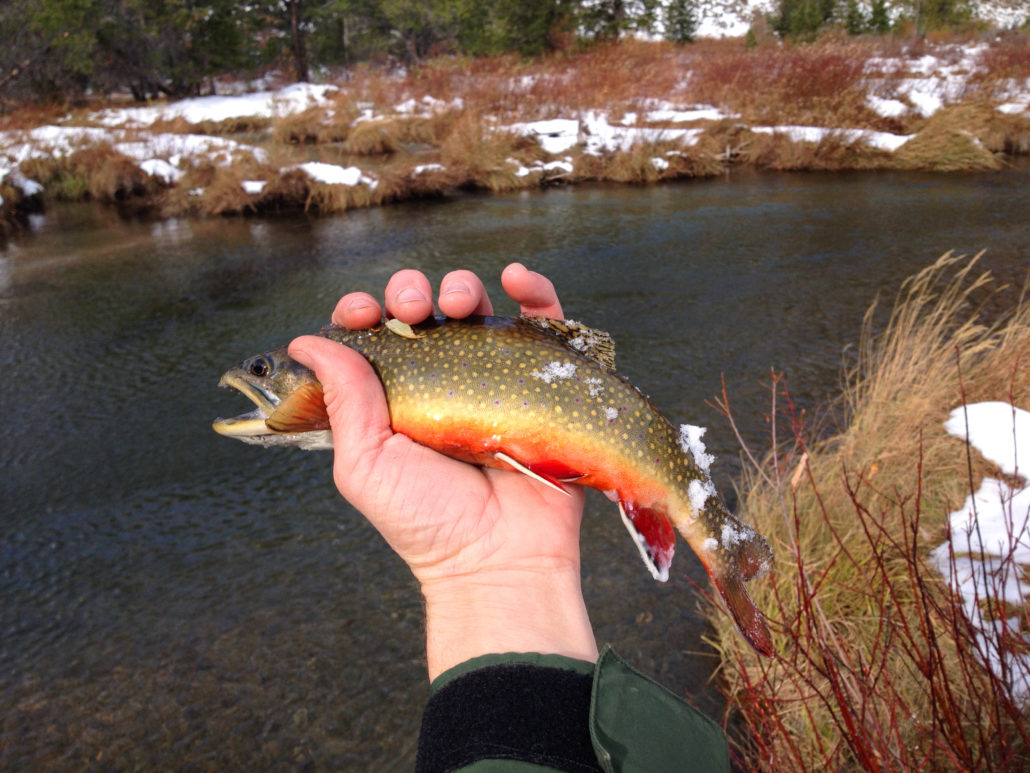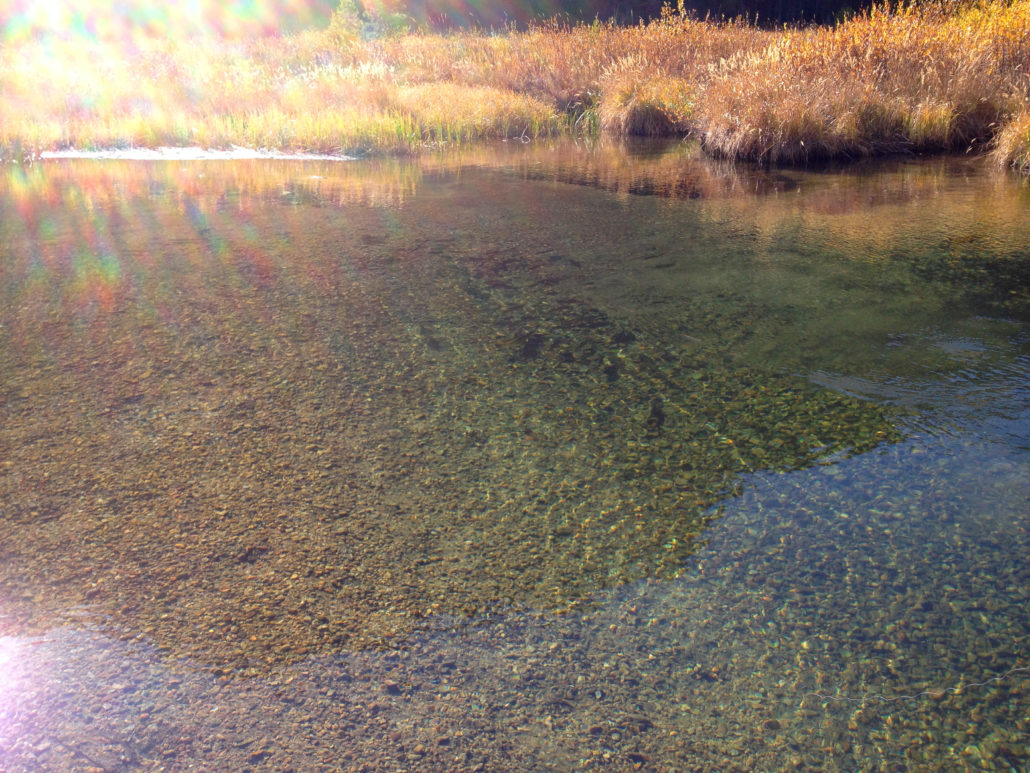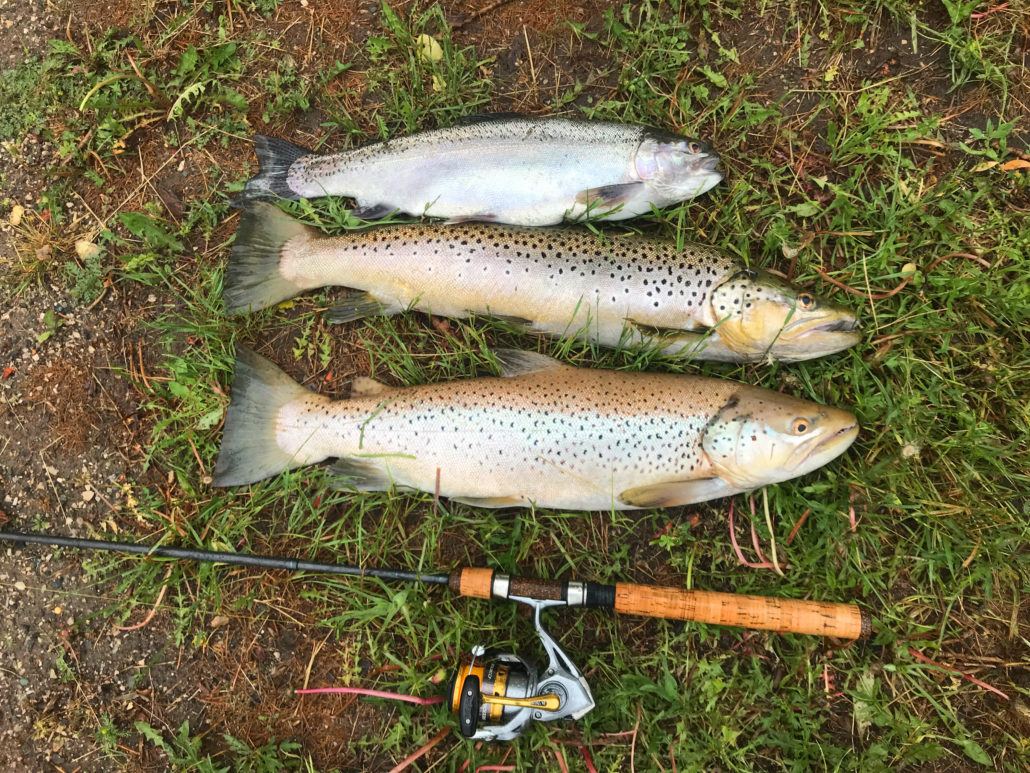How to Fish for Brown, Brook, and Rainbow Trout by Scott Sery
The Brown Trout, Brook Trout, and Rainbow Trout make up a significant portion of those caught every day.
There are more than 25 known species of trout throughout the world. Some live in lakes and oceans growing to enormous proportions, while others are rarely found outside of mountain streams and are typically the size of your hand. Fishing for these abundant fish is popular among fly fisherman and spin casters, and can be done all year round.
Among those 25 species of trout, there are three that are popular among anglers. The Brown Trout, Brook Trout, and Rainbow Trout make up a significant portion of those caught every day. Depending on where you are, the time of year, and the “mood” of the fish, catching them can take a variety of techniques.

Brown Trout
Brown Trout
The brown trout, easily identified by the orangish red spots mingled amongst brown spots along the upper sides of the fish, is native to Europe, but has been introduced to countries throughout world; coming to the US in the late 1800’s. With an average length in excess of 16 inches, most of the browns that you hook into will put up a good fight and provide a great meal if you take your quarry home.
When do Brown Trout Spawn?
Knowing when the different trout species spawn will help us understand how we need to fish for them. Brown trout are fall spawners. Depending on where you are fishing this can run from the middle of September, into late December and it plays a huge role in the size of fish that you will catch, as well as how to catch them.
Different species of fish will have different feeding habits during their spawn. When you’re fishing the smaller streams, and you see a school of brown trout, it can be tempting to plop down and throw everything you have at them. But alas, Brown Trout don’t feed at all during the spawn.
How to Fish for Brown Trout by Season
Spring – Many species of fish have babies hatching in the late winter or early spring. This causes a feeding frenzy for just about every other type of fish out there (including some of their own species). Because of the abundance of tiny fish that aren’t keen swimmers or predator aware, your best bet for catching predatory brown trout in the spring, and even into early summer, is with a minnow or a minnow shaped lure.
Summer – As the water warms, trout become less active. In the early part of the summer minnows can still work, as will night crawlers, but your best bet is to determine which bugs are hatching at any given time of year. Using the right fly, you can lure a lazy fish from the cool depths of lakes and rivers.
Fall – When a Brown Trout is spawning, it has one goal in mind: finish the spawn. That means they are eating more than usual to store up energy before the spawn, and they’re feeding voraciously after the spawn. Threading a plump worm onto the hook is an easy way to land a healthy sized fish.
Winter – Through the winter, the bugs aren’t flying. But the nymphs are in the water. Switching from the dry fly to the wet, you can still pull browns out even when the temps are well below freezing. Find the right river, and you can land a record fish; even though the cold water makes them sluggish, the limited food supplies makes them hungry!

Brook trout
Brook Trout
Brook Trout are often described as the most beautiful species of trout that you can catch. Their backs will usually contain yellow dots on a greenish background, while the sides are adorned with pink speckles contained inside blue halos; the males develop a striking orange underbelly as they mature. Often considered the smallest of the trout species, you’re more likely to catch them in the 8 – 12 inch range, but knowing where and how to fish can help you pull out larger specimens.
When do Brook Trout Spawn?
Brook Trout are also fall spawners. As the weather cools, they migrate upstream instinctively returning to their birthplace as many fish species do. While the brown trout will stick to a gravel or small pebble stream bottom, you can often find Brook Trout spawning in sandy bottomed streams.
Many species of fish will stop feeding during the spawn to focus on laying or fertilizing eggs. This is not true with Brook Trout. They’re hungry feeders that will devour just about any type of food, even in the middle of their spawn.

School of Brook
How to Fish for Brook Trout by Season
Spring – Brook Trout are often found in smaller streams rather than lakes or rivers. Because of this, they can be tough to fish for in the spring as they swell with rain and snow melt. To catch them, find the smaller streams, and drop a lure or worm just over the edge. The trout will come out from hiding under the banks.
Summer – As the streams dwindle in size, the trout will move from the small streams to the larger ones. They still like to hide under the banks and under overhanging bushes. Using an in-season fly, or live bait, you can lure them out of their hiding spots.
Fall – Fishing Brook Trout in the fall is far easier. As they school up for the spawn, they will sit in very conspicuous areas. As long as you can see them before they see you, a well placed worm or fly will bring in a fish at just about every cast. They’re hungry and a little stupid while they spawn. As soon as the school sees you they will stop biting.
Winter – Most of the streams will be frozen or non-running in the winter, so you need to find a spot where you can get these fish through the ice. This can be difficult, as different regions have different water flows. Generally speaking, Brook Trout don’t like deep water, and will hide a few hours after the sun comes up.
Trout are the most popular freshwater game fish. There’s a good reason for that: they’re abundant, found almost everywhere, and can be fished at any time.

Rainbow and Brown Trouts
Rainbow Trout
Rainbow Trout usually refers to the main species of fish (Oncorhynchus mykiss), but also contains a dozen or so subspecies. They’re native to North America and some parts of Asia, and have been introduced to many other parts of the world. They’re easily identifiable by the pink stripe that runs along the side of their bodies. Those found in lakes where sunlight doesn’t reach as deep into the water may be paler in color than those that live in shallow streams. Most stream and river dwelling Rainbow Trout will average 16 to 20 inches, they are commonly caught larger and much heavier out of lakes.
When do Rainbow Trout Spawn?
Rainbow Trout are spring spawners. The females will find an area along the gravel bottom of the streams where they were hatched, and form a small nest called a redd (a shallow depression in the sand or rocky bed of the stream). After the male has fertilized the eggs, the female will stay near the redd guarding it.
During the spawn Rainbow Trout will feed, but not as actively as they will before and after they are done. Their main intent is to spawn, but they won’t pass up a meal; especially if it’s an easy one.
How to Fish for Rainbow Trout by Season
Spring – As the fish spawn they are hungry due to the increased activity, but focused on spawning. To lure them off the river beds and onto your hook, your best bet is to use a salmon egg as they closely resemble trout eggs. Other live baits, like worms, will work as well if they happen to pass near the fish.
Summer – Post spawn Rainbow Trout are especially hungry. Discover which fly is in season if you’re fly fishing the area, use live bait such as minnows or worms, or you find a lure that closely mimics some sort of live bait that would normally be found in the area. Morning and evening, when it’s cooler, are the best times as the fish slow down during the heat of the day.
Fall – Fishing Rainbow Trout in the fall isn’t as much of what type of bait or lure to use, but more of where to fish for them. Decreased stream volumes mean they will be concentrated into the deeper spots. Using an in-season fly, or a simple live bait can lure them out of these pockets. Just make sure they don’t spot you, or they will stop biting.
Winter – Similar to Brown Trout, you can catch Rainbow Trout in the winter using a wet fly, or through the ice. When ice fishing for Rainbows, a live bait will be the most effective as the fish are hungry due to decreased food sources.

Trout Fishing Throughout the Year
Trout are the most popular freshwater game fish. There’s a good reason for that: they’re abundant, found almost everywhere, and can be fished at any time. The techniques and bait that you use will vary depending on where you are, but the general concepts are the same.
Before you head out, consider fishing ethics. There are many debates about fishing during the spawn and whether or not it should be done. These fish are stressed already, and even a safe catch-and-release can traumatize them causing death.
Get out, enjoy the water, hook a big one.


